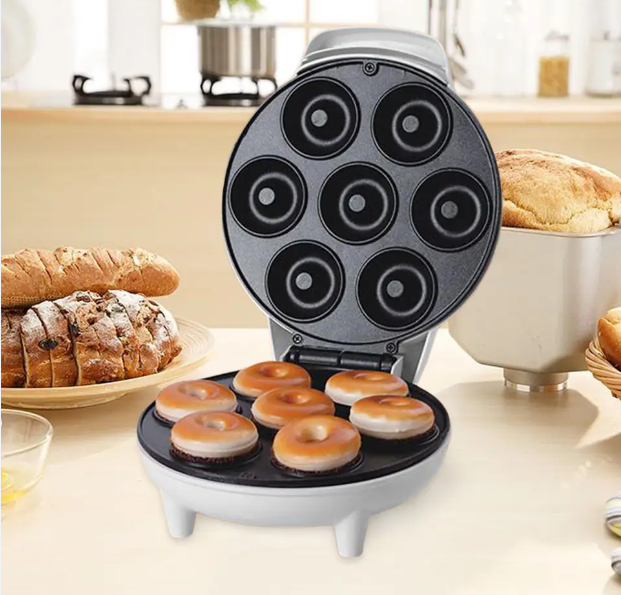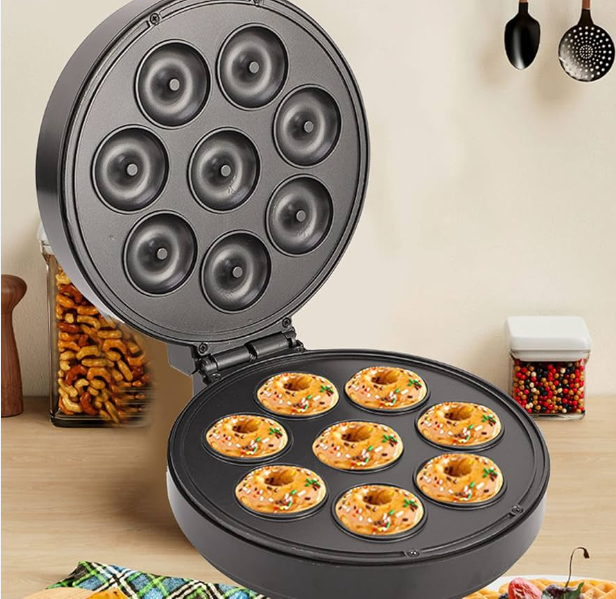Baking with a cake maker is a fun and convenient way to create delicious cakes, cupcakes, or cake pops, but safety is paramount to prevent accidents and ensure a worry-free experience. Whether you’re a beginner, baking with kids, or a professional, following cake maker safety tips is essential. In this comprehensive guide, we’ll explore the best practices for safe baking with a cake maker, alongside insights on cake maker setup, how to use a cake maker, cake maker troubleshooting, cake maker cleaning, and additional cake maker tips. Whether you’re using a portable cake maker or a high-capacity model, this guide will help you prioritize cake maker safety and cake maker maintenance to enjoy baking in 2025. Let’s dive into safe baking practices!
Why Prioritize Cake Maker Safety?
Using a cake maker involves heat and electricity, which can pose risks like burns or electrical hazards if not handled properly. Cake maker safety tips are crucial for protecting users, especially kids or beginners, and ensuring the appliance lasts longer through proper use and care. Modern cake makers, like those from Dash or Tefal, come with safety features such as cool-touch handles and non-slip bases, but following best practices enhances their safety. This guide provides actionable cake maker safety tips based on user feedback and industry standards, ensuring a secure and enjoyable baking experience. “These safety tips made baking with my kids stress-free!”
For more safety advice and baking recipes, visit the best cake maker guide at CakeMakerPro.
Top Cake Maker Safety Tips for 2025
Here are the most important cake maker safety tips to keep you and your loved ones safe while baking.
1. Read the Manual Before Use
Always review the manufacturer’s manual for your specific cake maker, such as the Babycakes Mini or Tefal Cake Factory, to understand its features, settings, and safety guidelines. Manuals detail proper operation, temperature limits, and safety features like cool-touch handles, helping you avoid misuse. “Reading the manual saved me from a preheat mistake!”
2. Use Heat-Resistant Tools
Handle hot molds or plates with oven mitts or silicone tongs to prevent burns, especially when removing treats from models like the Sunbeam Cupcake Maker. Ensure kids use heat-resistant tools under supervision to enhance cake maker safety. “Oven mitts made handling the hot plates so safe!”
3. Keep Away from Water
Never operate a cake maker near water or wet surfaces to avoid electrical hazards. Ensure hands are dry when plugging or unplugging the device, and avoid cleaning with water while it’s plugged in. This is critical for models like the Dash Mini Treat Maker. “Keeping it away from the sink prevented any scares!”
4. Supervise Children Closely
Even kid-friendly models like the Disney Mickey Mouse Cake Pop Maker require adult supervision during preheating, baking, and mold removal. Teach kids to use safe tools and avoid touching hot surfaces, ensuring cake maker safety at all times. “Supervising my kids made baking fun and safe!”
5. Inspect Regularly for Wear
Check the power cord, plates, and controls for signs of wear, fraying, or damage before each use, especially for high-use models like the Holstein Housewares Cake Pop Maker. Regular inspections prevent electrical issues and maintain safe operation. “Checking the cord caught a small fray early!”

Cake Maker Setup: Starting Safely
Proper cake maker setup is the foundation of safe baking. Follow these steps to ensure a secure setup:
- Unbox and Inspect: Verify all components, like molds, trays, or recipe guides, are included and undamaged before use.
- Clean Before Use: Wash removable parts with warm, soapy water to remove residues, ensuring hygiene and cake maker safety.
- Position Safely: Place the cake maker on a flat, heat-resistant surface away from water, edges, or flammable materials like curtains.
- Check Power Connection: Ensure the outlet is stable and compatible with the machine’s voltage requirements to avoid electrical risks.
- Preheat with Caution: Preheat for 3–5 minutes, as specified by models like the Tefal Cake Factory, keeping kids away during this step.
For more setup safety tips, visit the baking guide at CakeMakerPro.
How to Use a Cake Maker: Safe Baking Practices
Using a cake maker safely is key to a worry-free experience. Follow these cake maker safety tips during operation:
- Prepare Batter Safely: Mix ingredients away from the plugged-in machine to avoid spills or electrical contact.
- Grease Molds Carefully: Lightly grease nonstick plates with butter or spray, using a brush to avoid hand contact with hot surfaces.
- Fill Molds with Precision: Use a piping bag or scoop to fill molds two-thirds full, keeping hands clear of the machine to prevent burns.
- Avoid Opening During Baking: Don’t open the lid mid-cycle, as steam or heat can cause burns, especially with models like the Sunbeam Cupcake Maker.
- Use Timer or Indicator Lights: Rely on indicator lights or set an external timer for models like the Dash Mini to avoid overcooking and ensure safe operation.
- Remove Treats Safely: Let treats cool slightly before removing with silicone tools or mitts to avoid burns.
For more on how to use a cake maker safely, explore CakeMakerPro.
Cake Maker Troubleshooting: Addressing Safety Concerns
Even the best cake maker can encounter issues that impact safety. Here are cake maker troubleshooting tips with safety in mind:
- Uneven Baking: Ensure even batter distribution and full preheating to avoid hot spots that could cause burns when removing unevenly baked treats.
- Sticking Cakes: Grease molds lightly to prevent sticking, reducing the need to pry treats out and risk touching hot surfaces.
- Overheating or Burning: Reduce baking time or adjust batter consistency to avoid excessive heat buildup, which can pose burn risks.
- Machine Not Heating: Unplug immediately if the machine doesn’t heat properly. Check the cord and outlet, and contact support to avoid electrical hazards.
Regular cake maker maintenance prevents safety issues. Clean and store properly to ensure safe operation.
Cake Maker Cleaning: Safe and Hygienic Practices
Proper cake maker cleaning is essential for safety and hygiene. Follow these cake maker safety tips during cleaning:
- Unplug and Cool Completely: Always unplug the machine and let it cool fully before cleaning to avoid electrical shocks or burns.
- Remove Parts Safely: Detach molds or trays carefully, using mitts if still warm, and wash with warm, soapy water using a soft sponge to protect nonstick coatings.
- Avoid Immersion: Never submerge the machine in water, as this can damage electrical components and create hazards.
- Wipe Exterior Carefully: Clean the exterior and control panel with a damp cloth, ensuring no water enters the machine.
- Dry Thoroughly: Dry all parts completely before reassembling or storing to prevent moisture-related electrical issues.
For more cake maker maintenance safety tips, visit CakeMakerPro’s maintenance tips section.
Additional Cake Maker Safety Tips
Beyond basic operation, these cake maker safety tips enhance protection:
- Use Stable Surfaces: Avoid placing the cake maker on uneven surfaces to prevent tipping, especially during use by kids.
- Store Safely: Store the machine unplugged in a dry, inaccessible place to prevent children from tampering with it.
- Limit Continuous Use: Allow the machine to cool between batches to prevent overheating, as recommended for models like the Holstein Housewares.
- Educate Kids: Teach children about hot surfaces and electrical safety before letting them assist, ensuring they understand risks.
- Unplug When Not in Use: Always unplug the cake maker after use to avoid accidental activation or electrical issues.

Cake Maker Tips: Enhancing Safety and Fun
Maximize your cake maker experience with these cake maker tips that prioritize safety:
- Start with Simple Recipes: Use store-bought mixes or basic recipes like vanilla cupcakes to minimize complexity and focus on safe operation.
- Use Kid-Friendly Tools: Provide piping bags or scoops to keep kids’ hands away from hot molds during filling.
- Decorate Safely: Let kids decorate cooled treats with sprinkles or icing to avoid handling hot items, adding fun without risk.
- Batch Baking Safely: Bake small batches to avoid rushing, ensuring kids and beginners stay safe during the process.
- Try Safe Flavors: Experiment with 2025 trends like fruit-based cupcakes or mini muffins, keeping recipes simple to reduce errors.
Pros and Cons of Cake Maker Safety
Pros:
- Safety features like cool-touch handles and non-slip bases reduce risks.
- Fast baking times (4–10 minutes) minimize exposure to heat.
- Nonstick surfaces simplify safe cleanup.
- Compact designs enhance cake maker safety in small spaces.
Cons:
- Requires constant adult supervision for kids.
- Some models lack advanced safety features like auto shut-off.
- Hot surfaces still pose risks if not handled carefully.
Conclusion: Are Cake Makers Safe with Proper Precautions?
With the right cake maker safety tips, cake makers are a safe and enjoyable way to bake delicious treats. This cake maker safety tips review has outlined essential practices to ensure cake maker safety, alongside insights on the best cake maker models like the Babycakes Mini, Dash Mini Treat Maker, and Tefal Cake Factory. By following our advice on cake maker setup, how to use a cake maker, cake maker troubleshooting, and cake maker cleaning, you can create a secure baking environment for yourself, kids, or professionals. Whether baking for fun or parties, prioritizing cake maker safety ensures a worry-free experience in 2025.
Ready to bake safely? Visit CakeMakerPro for expert safety tips, recipes, and cake maker maintenance advice to make your baking journey a success!